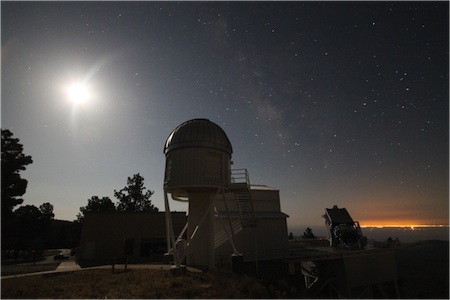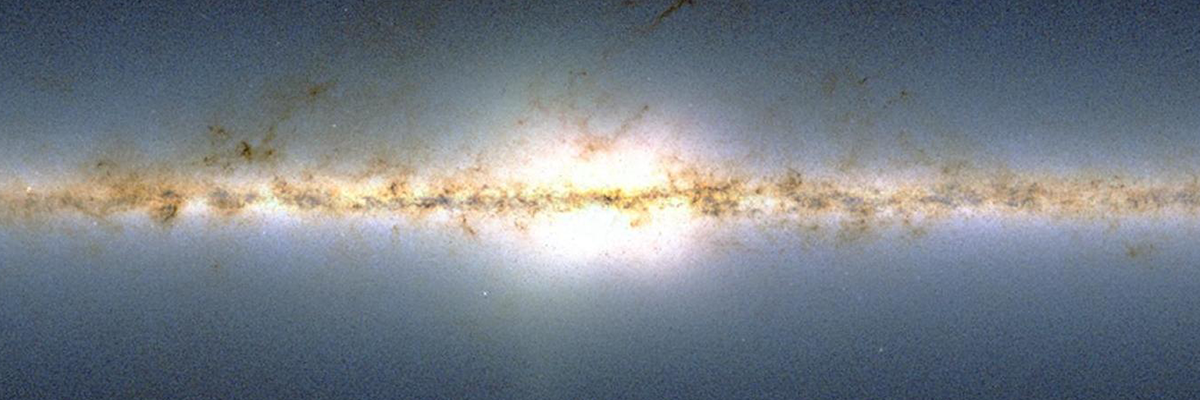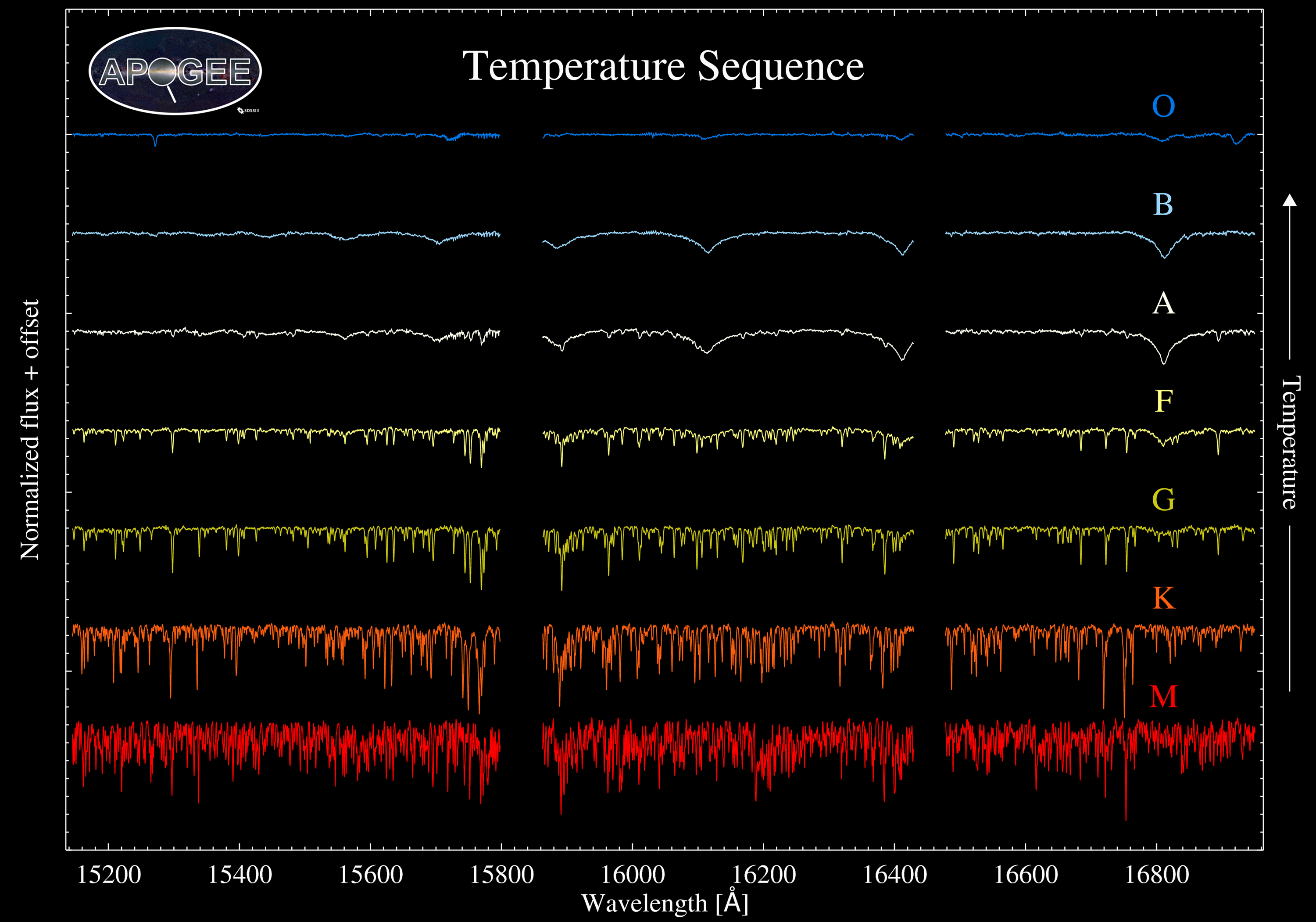APOGEE-2 Background
Why is APOGEE designed the way it is? And what is APOGEE trying to do? The following questions and answers will describe some of the technical language used in order to understand how APOGEE works.
Why are we studying stars in the infrared?
Infrared wavelengths were chosen to study stars in APOGEE and APOGEE-2 for two very important reasons. If you have ever seen the night sky from a dark, lonely site, you may be able to figure out one of them. On a night when the Moon is out, the sky is awash with its light. One of the things you will notice is that not many stars are visible. If, on the other hand, you venture out on a night that is moonless, you will see hundreds, even thousands of fainter stars that were invisible to you when the Moon was out. You may even be able to see the Milky Way as a faint streak across the sky! The reason that you can see so many faint stars on a moonless night but only the brightest ones on a moonlit night is because of our atmosphere. Our atmosphere, which protects us from many harmful things from outer space, such as ultraviolet light, also scatters the light that we see. So, when a big, bright object is in the sky like the Sun or Moon, the sky is full of light bouncing off of particles in the atmosphere, obscuring our view of what lies beyond.
The infrared helps us see past the moonlight. Whereas the visible light that we can see with our eyes is heavily scattered by the atmosphere, the infrared is not, so that even when the Moon is out, we can still see stars in infrared light. Prior to starting APOGEE, the Sloan Digital Sky Survey (SDSS) only operated using optical light and so the telescope was "idle" when the Moon was out. The APOGEE instruments were proposed to use this time more productively.
The same property of infrared light that lets us observe when the Moon is out also helps us see past the "dust" within the Milky Way Galaxy itself, which is shown in the image at the top of this page in what look like swirls and clouds. Since this dust inhibits our view of what lies beyond it, just like a lot of dust or dirt in the atmosphere does on Earth, using infrared light helps us to see stars all the way across the Milky Way. This is very helpful when building a history of the whole Galaxy.
But merely taking pictures of stars in the infrared would not help us answer our science questions. While taking images of stars is very useful for many other science objectives, we cannot learn about how a star is made or how fast it is moving from images alone. Instead, we make use of spectra (singular: spectrum).
What are spectra, and why are they useful?
Spectra are like a rainbow: a rainbow is sunlight that, by passing through water droplets in the atmosphere, is split into its constituent colors. We can split light up in a laboratory or at a telescope, too, using a piece of glass called a prism, or else with a fancier piece of equipment known as a diffraction grating (this is what APOGEE uses). And splitting up light is a very useful thing to do. It was by making a spectrum of sunlight that astronomers first identified what the Sun is primarily made of (the Sun is composed largely of hydrogen and helium). And in the same way, when we make spectra of other stars, we get to see signatures of not only the predominant elements of hydrogen and helium, but also many other elements besides: carbon, nitrogen, oxygen, and perhaps fifty others on the periodic table of the elements. The elements that we can detect in stars across the Milky Way with APOGEE include carbon, nitrogen, oxygen, and iron. By carefully studying how much of each of these elements we are seeing in each star, we can piece together (1) the location in the Milky Way that these stars are located (the disk, bulge, or halo), and (2) how old these stars are.
SDSS Voyages provides a discussion of spectra and spectral types using SDSS optical data.
Spectra are also useful for determining how fast a star is moving through space. This is due to the phenomenon known as the Doppler shift. When a star is moving, its velocity has an effect on the light that it is emitting. For instance, if that star is moving towards us, its light will appear slightly bluer to us, and we call that blueshift. If, on the other hand, the star is moving away from us, its light will appear slightly redder to us, and so we call that redshift. These slight shifts in the light from a star can best be detected using the spectral signatures from the elements listed in the previous paragraph. If we see a signature for iron, say, which is at a wavelength of light that is slightly bluer than we know it should be, we know that this star is moving towards us, and at what speed.
What are the main components of the Milky Way?
At the center of the Milky Way's disk is the bulge, which is like a ball of stars that sticks out from the disk on either side. There is an interesting difference between stars in the disk and stars in the bulge. Stars in the disk cover a wide range of age, from very, very old stars to new stars that are just being born. But there are no young stars in the bulge -- no star formation is occurring there today. One of the ways we are able to detect that is by measuring the signatures of the elements in their spectra. Stars with more of certain elements tend to be younger, whereas stars with less of those elements tend to be older. So, if we do not a priori know how old a star is or whether it lies in the disk or the bulge (remember: the bulge is in the disk, which creates quite a bit of confusion!), we can use its spectrum to help us figure that out.
Surrounding the disk and the bulge lies the third component of the Milky Way: the halo. It is so named because it is a very diffuse, very large and all-encompassing group of stars. The stars in the halo have the lowest recorded elemental abundances of any stars in the Milky Way -- this means that they are the oldest stars around! And some of them, we think, are almost as old as the Universe itself. Though there are not many of them, the stars in the halo are fascinating to study because they give us a view of what all stars looked like long ago. And by comparing them to the stars in the bulge and the disk, we can begin to piece together, like an archeologist digging up an ancient site under a modern city, what the Milky Way was like from its formation until now, and how things have changed over this vast period of time.
Why do we need telescopes in both hemispheres?
The goal of APOGEE is to observe all major components of the Milky Way and to do so with a consistent set of data and analyses. This way we can compare the properties of the different components without having to worry about systematic differences between different datasets. However, because the Milky Way Galaxy really does span the full sky, we have to be able to observe the
A telescope at most locations on the Earth will only be able to view a part of the sky because the Earth blocks part of the sky. The figure shows the fraction of the Milky Way that is visible from Apache Point Observatory in the Northern Hemisphere (top) and the portion of the Milky Way that is visible from Las Campanas Observatory (bottom). APOGEE-1 that only took observations from Apache Point Observatory was not able to see the full bulge and part of the disk. With telescopes at both sites, we are able to see the entire Milky Way.
More Resources
- SDSS Voyages is a bi-lingual (English and Spanish) website designed to teach fundamental astronomy concepts using SDSS data. It provides deeper information on a number of topics discussed here. Voyages is maintained by the Education and Public Outreach Group within SDSS.
- NASA's Tour of the Electromagnetic Spectrum provides detailed information about how astronomers and physicists use light to understand the Universe.
- NASA's Imagine the Universe is a kid-friendly website with activities and videos that teach concepts related to Astronomy.







